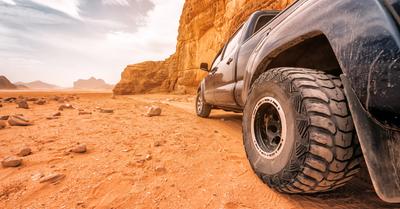Using street-legal parts to go off road is not recommended. The same is true for the exhaust system, but let's first understand what an off-road exhaust is.
Off-road exhausts are important for vehicles. The design differs to create more airflow, better engine performance, reduced heat generation, better durability, higher ground clearance, and a better sound while driving. This exhaust is also not street-legal and does not have a catalytic converter.
Off-road exhausts effectively reduce noise, improve performance, and increase fuel efficiency. We have previously worked with various off-road vehicles, so installing and analyzing these components is second nature. Below is personal research compiled and everything needed to know about these exhaust systems.
Key Takeaways
- An off road exhaust is made of more durable stainless steel and gets angled differently to help improve airflow and fuel efficiency while reducing heat generation for better durability and engine performance.
- The different types of off road exhausts include the Single Exit Exhaust, Dual Rear Exit Exhaust, Opposite Dual Exhaust, Dual Side Exhaust, and High-Performance Exhaust.
- The primary difference between an on road and off road exhaust is the exhaust materials, exhaust angle, and catalytic converter presence.
This article may contain affiliate links where we earn a commission from qualifying purchases.
What Is an Off Road Exhaust?
Off road exhausts are used on modified OHVs. These exhausts are made to be more durable and can be fitted to a range of different vehicles.
They are illegal for street use because they don’t have a catalytic converter. This is required in all street-legal vehicles to reduce emissions for the environment.
An off-road exhaust system is designed to provide more engine power directed through a larger diameter pipe than would normally be possible.
This increases the engine's torque output and allows it to perform better in difficult conditions, such as deep snow or muddy terrain where traction is limited.
Since the car’s exhaust system sits at the bottom of the truck or the jeep, it is subject to a great deal of abuse during off-road journeys. So, as an off-roader, they must pay attention to the vehicle’s exhaust setup.
The design is built to last with better ground clearance, so there is minimal damage risk when riding through off road terrains.
Why Off Road Exhausts Are Important
An exhaust is responsible for ensuring that a vehicle is ‘breathing’ in an optimal manner. If there is an obstruction in our lungs, it can keep us from breathing properly.
Similarly, improper functioning of the exhaust system will cause problems in the overall functioning of the car’s engine. Overall, they are critical and provide a few key benefits for off road driving.
Improved Airflow
An off-road exhaust is important and beneficial because it provides improved airflow, improving engine performance while reducing heat generation.
Compared to a stock exhaust, this is much more critical for off-roading and off road vehicles. It also allows for better horsepower, torque, and power distribution.
They can also reduce fuel consumption by increasing torque output. Off-road exhaust systems can be installed on any car, but it's important to note that they are not legal for use on public roads.
Better Durability
Off road exhausts are made with a thicker wall thickness, which provides much more protection to the engine. They also have a higher flow capacity, which means that they can push more air through the engine and produce more power.
They also have a larger diameter and taller pipes, which helps in reducing back pressure. These exhausts are built stronger and provide much better durability than the stock exhaust.
Higher Ground Clearance
An off-road exhaust system that is correctly positioned will usually not strike any obstacles present on the trails. This includes higher ground clearance for climbing and driving on steep terrain types.
Like the tailpipes, mufflers, and extension pipes, a catalytic converter can also shift to a safer position under the chassis.
This means that even if an undercarriage strikes the ground, the frame rails are the only part that will come into direct contact. Your exhaust system will remain protected and free of damage.
Better Sound While Driving
Many owners of off-road vehicles turn to off-road exhaust systems solely due to the improved growling and mellow sound. This is possible because the exhaust is less restricted.
The sound is more natural, deep, and distinct. It makes the off road vehicle sound much better when handling these difficult road conditions.
What Are The Different Types Of Off Road Exhausts?
Off-road exhausts are designed to be used in difficult environments such as on dirt, sand, mud, snow, or even water. The configuration used impacts performance, and below are the different types of off road exhausts.
Single Exit Exhaust
A single exhaust system uses a single pipe to remain lightweight. This pipe will route the gasses out of the vehicle.
This exhaust type is on many factory cars, but the difference here is the upgrade to the off road single exit exhaust system. They operate similarly, but it’s raised and angled for better airflow and ground clearance.
Dual Rear Exit Exhaust
The dual rear exit exhaust is uncommon on off road vehicles because there are two exhaust pipes. One pipe is located on each side of the car.
This makes it difficult to create ground clearance, so handling the vehicle on rugged terrains takes work. The pipes also don’t bend around the vehicle.
Opposite Dual Exhaust
This is a type of exhaust system that has two separate pipes. This design allows for a lower center of gravity, less weight, and better aerodynamics.
This exhaust system is common on bigger trucks too. It allows for optimal ground clearance when used for off road driving too.
Dual Side Exhaust
The dual-side exhaust can be useful in some scenarios, as it puts both exhaust pipes on one side of the vehicle. They are usually right next to each other to create more ground clearance and space.
High-Performance Exhaust
Off-road exhausts are made with the latest technology and materials. The vehicle's engine is protected from heat by an outer sleeve that prevents it from overheating.
They also have a high flow rate which helps in providing more power to the engine. This is why many vehicles use high-performance off road exhausts.
What’s The Difference Between On Road And Off Road Exhausts?
If you check the underside of a car, you will usually notice that a regular exhaust has a muffler present close to the ground.
The position of this muffler is considerably lower compared to the positions of most of the other under-carriage vehicle components.
These environments can be extremely harsh on the vehicle’s engine and other car parts. Off-road exhausts help prevent the vehicle from overheating and damaging itself while driving across deep sand or rocky terrain.
The tailpipes and mufflers are particularly prone to brushing against surfaces or other obstacles present in off-road terrains. This type of damage is a major risk when using an on-road exhaust for off-roading.
Once damaged, these parts need to be replaced or repaired. This can then cost a great deal of money and time, so we recommend avoiding this risk and upgrading to an off road exhaust before taking a vehicle into rugged conditions.









